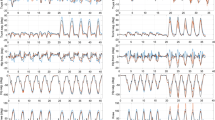Abstract
In this study, we conducted an experiment for validating a motion estimation system used in novel mirror therapy. The proposed motion estimation system consists of two parts. The first part is motion estimation using attitude and heading reference system sensors. The system attaches a reference frame to a patient to provide flexibility to the patient’s movements. The second part is a compensation algorithm that uses principal component analysis (PCA). Ten subjects performed simple reaching tasks for the validation experiment. The results showed success rate of 89.67% under normal conditions. The PCA-based compensation algorithm increases the success rate from 89.67 to 92.89%. Accurate capturing of healthy arm motion will make effective robot-aided mirror therapy systems feasible.




Similar content being viewed by others
References
Sarakoglou, I., Caldwell, D. G., Tsagarakis, N. G., & Kousidou, S. (2007). Exoskeleton-based exercisers for the disabilities of the upper arm and hand. INTECH Open Access Publisher.
Niu, X., Varoqui, D., Kindig, M., & Mirbagheri, M. M. (2014). Prediction of gait recovery in spinal cord injured individuals trained with robotic gait orthosis. Journal of Neuroengineering and Rehabilitation, 11(1), 1.
Krebs, H. I., Hogan, N., Aisen, M. L., & Volpe, B. T. (1998). Robot-aided neurorehabilitation. IEEE Transactions on Rehabilitation Engineering, 6(1), 75–87.
Kwakkel, G., Wagenaar, R. C., Koelman, T. W., Lankhorst, G. J., & Koetsier, J. C. (1997). Effects of intensity of rehabilitation after stroke a research synthesis. Stroke, 28(8), 1550–1556.
Nef, T., Guidali, M., & Riener, R. (2009). ARMin III–arm therapy exoskeleton with an ergonomic shoulder actuation. Applied Bionics and Biomechanics, 6(2), 127–142.
Hamzei, F., Läppchen, C. H., Glauche, V., Mader, I., Rijntjes, M., & Weiller, C. (2012). Functional plasticity induced by mirror training the mirror as the element connecting both hands to one hemisphere. Neurorehabilitation and Neural Repair, 26(5), 484–496.
Thieme, H., Mehrholz, J., Pohl, M., Behrens, J., & Dohle, C. (2013). Mirror therapy for improving motor function after stroke. Stroke, 44(1), e1–e2.
Dohle, C., Püllen, J., Nakaten, A., Küst, J., Rietz, C., & Karbe, H. (2009). Mirror therapy promotes recovery from severe hemiparesis: A randomized controlled trial. Neurorehabilitation and Neural Repair, 23(3), 209–217.
Semrau, J. A., Herter, T. M., Scott, S. H., & Dukelow, S. P. (2013). Robotic identification of kinesthetic deficits after stroke. Stroke, 44(12), 3414–3421.
Smorenburg, A. R., Ledebt, A., Deconinck, F. J., & Savelsbergh, G. J. (2013). Practicing a matching movement with a mirror in individuals with spastic hemiplegia. Research in Developmental Disabilities, 34(9), 2507–2513.
De Santis, D., Zenzeri, J., Casadio, M., Masia, L., Riva, A., Morasso, P., et al. (2015). Robot-assisted training of the kinesthetic sense: enhancing proprioception after stroke. Frontiers in Human Neuroscience, 8, 1037.
Reinkensmeyer, D. J., Lehman, S. L., & Lum, P. S. (1993). A bimanual therapy robot: controller design and prototype experiments. Proc. IEEE the 15th Annual Internal. Conf. on Engineering in Medicine and Biology Society, 938-939.
Lum, P. S., Burgar, C. G., Shor, P. C., Majmundar, M., & Van der Loos, M. (2002). Robot-assisted movement training compared with conventional therapy techniques for the rehabilitation of upper-limb motor function after stroke. Archives of Physical Medicine and Rehabilitation, 83(7), 952–959.
Burgar, C. G., Lum, P. S., Shor, P. C., & Van der Loos, H. M. (2000). Development of robots for rehabilitation therapy: the Palo Alto VA/Stanford experience. Journal of Rehabilitation Research and Development, 37(6), 663–674.
WANG, W.-W., FU, L.-C. (2011). Mirror therapy with an exoskeleton upper-limb robot based on IMU measurement system. Proceedings of the IEEE International Workshop on Medical Measurements and Applications (MeMeA), pp. 370–375.
Vlasic, D., Adelsberger, R., Vannucci, G., Barnwell, J., Gross, M., Matusik, W., et al. (2007). Practical motion capture in everyday surroundings. ACM Transactions on Graphics (TOG), 26(3), 35.
Luinge, H. J., & Veltink, P. H. (2005). Measuring orientation of human body segments using miniature gyroscopes and accelerometers. Medical & Biological Engineering & Computing, 43(2), 273–282.
Hyde, R. A., Ketteringham, L. P., Neild, S. A., & Jones, R. J. (2008). Estimation of upper-limb orientation based on accelerometer and gyroscope measurements. IEEE Transactions on Biomedical Engineering, 55(2), 746–754.
Zhu, R., & Zhou, Z. (2004). A real-time articulated human motion tracking using tri-axis inertial/magnetic sensors package. IEEE Transactions on Neural Systems and Rehabilitation Engineering, 12(2), 295–302.
Zhou, H., Hu, H., & Tao, Y. (2006). Inertial measurements of upper limb motion. Medical & Biological Engineering & Computing, 44(6), 479–487.
Schiele, A., & van der Helm, F. C. (2006). Kinematic design to improve ergonomics in human machine interaction. IEEE Transactions on Neural Systems and Rehabilitation Engineering, 14(4), 456–469.
Zhou, H., & Hu, H. (2010). Reducing drifts in the inertial measurements of wrist and elbow positions. IEEE Transactions on Instrumentation and Measurement, 59(3), 575–585.
Beom, J., Koh, S., Nam, H. S., Kim, W., Kim, Y., Seo, H. G., et al. (2016). Robotic mirror therapy system for functional recovery of hemiplegic arms. Journal of Visualized Experiments (JoVE), 114, e54521–e54521.
Iosa, M., Morone, G., Cherubini, A., & Paolucci, S. (2016). The three laws of neurorobotics: A review on what neurorehabilitation robots should do for patients and clinicians. Journal of Medical and Biological Engineering, 36(1), 1–11.
Acknowledgements
This work was funded by the 2012 Seoul National University Brain Fusion Program (Grant Number: 800-20120444) and BK21 Plus Program through the National Research Foundation of Korea funded by the Ministry of Education (Grant Number: 22A20130011025).
Author information
Authors and Affiliations
Corresponding author
Rights and permissions
About this article
Cite this article
Kim, W., Beom, J., Park, C. et al. Reliability and Validity of Attitude and Heading Reference System Motion Estimation in a Novel Mirror Therapy System. J. Med. Biol. Eng. 38, 370–377 (2018). https://doi.org/10.1007/s40846-017-0315-4
Received:
Accepted:
Published:
Issue Date:
DOI: https://doi.org/10.1007/s40846-017-0315-4




